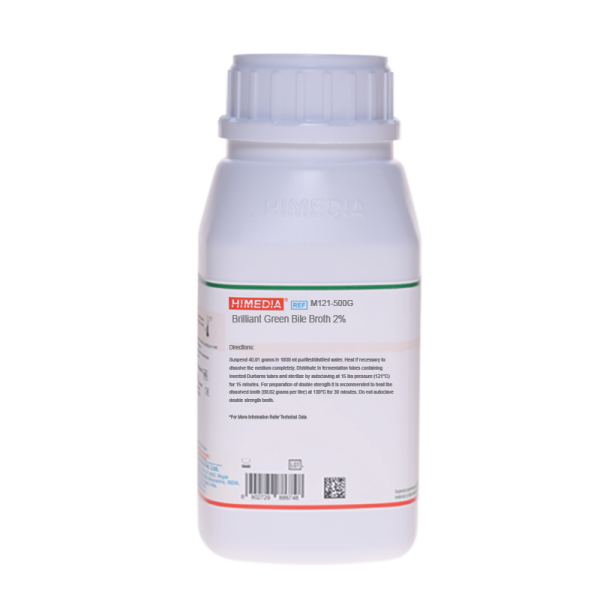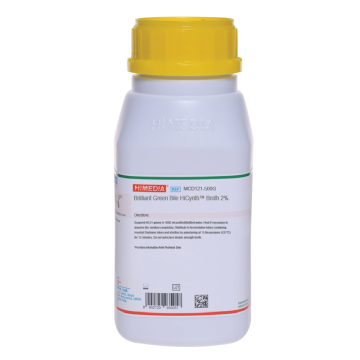 Your enquiry has been submitted
Your enquiry has been submitted
Brilliant Green Bile Broth, 2%
Enterobacteriaceae#CC293D
Intended Use:
Recommended for detection and confirmation of coliform bacteria in water, waste water, food, milk and dairy products.
Composition**
| Ingredients | g/L |
|---|---|
| Peptone | 10.000 |
| Lactose | 10.000 |
| Bile# | 20.000 |
| Brilliant green | 0.0133 |
Final pH (at 25°C): 7.2±0.2
**Formula adjusted, standardized to suit performance parameters
# - Equivalent to Oxgall
Directions
Suspend 40.01 grams in 1000 ml purified/distilled water. Heat if necessary to dissolve the medium completely. Distribute in fermentation tubes containing inverted Durhams tubes and sterilize by autoclaving at 15 lbs pressure (121°C) for 15 minutes. For preparation of double strength it is recommended to heat the dissolved broth (80.02 grams per litre) at 100°C for 30 minutes. Do not autoclave double strength broth.
Principle And Interpretation
Brilliant Green Bile Broth 2% is one of the most widely used medium for the detection of coliform bacteria in water, wastewater, foods, and milk and dairy products. This medium is formulated as per APHA (1,2,3) for the presumptive identification and confirmation of coliform bacteria (4,5). This medium is also recommended by the ISO Committee for enumeration of coliforms by most probable number technique (6).
Peptone serves as a source of essential nutrients. Lactose is the fermentable carbohydrate. Bile inhibits gram-positive bacteria whereas the gram-negative bacteria are inhibited by brilliant green. Production of gas from lactose fermentation is detected by incorporating inverted Durham's tube, which indicates the positive evidence of faecal coliform since non faecal coliforms growing in this medium do not produce gas. Further gas production in EC broth (M127) at 45°C used as a confirmation of faecal coliform. Gram-positive spore formers may produce gas if the bile or brilliant green inhibition is weakened by reaction with food material.
During examination of water samples, growth from presumptive positive tubes showing gas in Lactose Broth (M026) or Lauryl Tryptose Broth (M080) is inoculated in Brilliant Green Bile Broth 2% (M121). Gas formation within 48 ± 2 hours confirms the presumptive test (1).
Type of specimen
Food and dairy samples; Water samples
Specimen Collection and Handling:
For food and dairy samples, follow appropriate techniques for sample collection and processing as per guidelines (3,7,8). For water samples, follow appropriate techniques for sample collection, processing as per guidelines and local standards (9). After use, contaminated materials must be sterilized by autoclaving before discarding.
Warning and Precautions :
Read the label before opening the container. Wear protective gloves/protective clothing/eye protection/ face protection. Follow good microbiological lab practices while handling specimens and culture. Standard precautions as per established guidelines should be followed while handling specimens. Safety guidelines may be referred in individual safety data sheets.
Limitations :
- Do not autoclave double-strength broth.
- Gram-positive sporing organisms may produce gas if the bile/brilliant green inhibition is attenuated by foodmaterial.
Performance and Evaluation
Performance of the medium is expected when used as per the direction on the label within the expiry period when stored at recommended temperature.
Quality Control
Appearance Cream to pale green coloured homogeneous free flowing powder.
Colour and Clarity of prepared medium Emerald green coloured, clear solution without any precipitate.
Reaction Reaction of 4.0% w/v aqueous solution at 25°C. pH: 7.2±0.2
pH 7.00-7.40
Cultural Response
Cultural characteristics observed after an incubation at 35-37°C for 18-48 hours.
| Organism | Inoculum (CFU) | Growth | Gas |
|---|---|---|---|
| Bacillus cereus ATCC 10876 | >=104 | inhibited | |
| Escherichia coli ATCC 25922 (00013*) | 50-100 | good-luxuriant | positive reaction |
| # Klebsiella aerogenes ATCC 13048 (00175*) | 50-100 | good-luxuriant | positive reaction |
| Enterococcus faecalis ATCC 29212 (00087*) | 50-100 | none-poor | negative reaction |
| Staphylococcus aureus subsp. aureus ATCC 25923 (00034*) | >=104 | inhibited |
Key: (*) Corresponding WDCM numbers (#) Formerly known as Enterobacter aerogenes
Storage and Shelf Life
Store between 10-30°C in a tightly closed container and the prepared medium at 15-25°C. Use before expiry date on the label. On opening, product should be properly stored dry, after tightly capping the bottle in order to prevent lump formation due to the hygroscopic nature of the product. Improper storage of the product may lead to lump formation. Store in dry ventilated area protected from extremes of temperature and sources of ignition. Seal the container tightly after use. Product performance is best if used within stated expiry period.
Disposal
User must ensure safe disposal by autoclaving and/or incineration of used or unusable preparations of this product. Follow established laboratory procedures in disposing of infectious materials and material that comes into contact with sample must be decontaminated and disposed of in accordance with current laboratory techniques (9,10).
Reference
- Lipps WC, Braun-Howland EB, Baxter TE,eds. Standard methods for the Examination of Water and Wastewater, 24th ed. Washington DC:APHA Press; 2023.
- Richardson G., (Ed.), 1985, Standard Methods for the Examination of Dairy Products, 15th Ed, APHA, Washington, D.C.
- Salfinger Y., and Tortorello M.L. Fifth (Ed.), 2015, Compendium of Methods for the Microbiological Examination of Foods, 5th Ed., American Public Health Association, Washington, D.C.
- McCrady and Langerin, 1932, J. Dairy Science, 15:321.
- McCrady, 1937, Am. J. Publ. Health, 27:1243.
- International Organization for Standardization (ISO), 1991, Draft ISO/DIS 4831.
- American Public Health Association, Standard Methods for the Examination of Dairy Products, 1978, 14th Ed., Washington D.C.
- Wehr H. M. and Frank J. H., 2004, Standard Methods for the Microbiological Examination of Dairy Products, 17th Ed., APHA Inc., Washington, D.C.
- Isenberg, H.D. Clinical Microbiology Procedures Handbook 2nd Edition.
- Jorgensen, J.H., Pfaller, M.A., Carroll, K.C., Funke, G., Landry, M.L., Richter, S.S and Warnock., D.W. (2015) Manual of Clinical Microbiology, 11th Edition. Vol. 1
| Product Name | Brilliant Green Bile Broth, 2% |
|---|---|
| SKU | M121 |
| Product Type | Regular |
| Physical Form | Powder |
| Origin | Animal |
| Packaging type | HDPE |
| References | 1. American Public Health Association, Standard Methods for the Examination of Dairy Products, 1978, 14th Ed.,Washington D.C. 2.Baird R.B., Eaton A.D., and Rice E.W., (Eds.), 2015, Standard Methods for the Examination of Water and Wastewater,23rd ed., APHA, Washington, D.C. 3.Greenberg A. E., Eaton A. D. and Clesceri L. S., (Eds.), 1998, Standard Methods for the Examination of Water andWastewater, 20th ed., APHA, Washington, D.C. 4.International Organization for Standardization (ISO), 1991, Draft ISO/DIS 4831. 5.Isenberg, H.D. Clinical Microbiology Procedures Handbook 2nd Edition. 6.Jorgensen, J.H., Pfaller, M.A., Carroll, K.C., Funke, G., Landry, M.L., Richter, S.S and Warnock., D.W. (2015) Manualof Clinical Microbiology, 11th Edition. Vol. 1 9.Richardson G., (Ed.), 1985, Standard Methods for the Examination of Dairy Products, 15th Ed, APHA, Washington, D.C. 10.Salfinger Y., and Tortorello M.L. Fifth (Ed.), 2015, Compendium of Methods for the Microbiological Examination ofFoods, 5th Ed., American Public Health Association, Washington, D.C. 11. Wehr H. M. and Frank J. H., 2004, Standard Methods for the Microbiological Examination of Dairy Products, 17th Ed.,APHA Inc., Washington, D.C |
| Customized Product Available | No |








